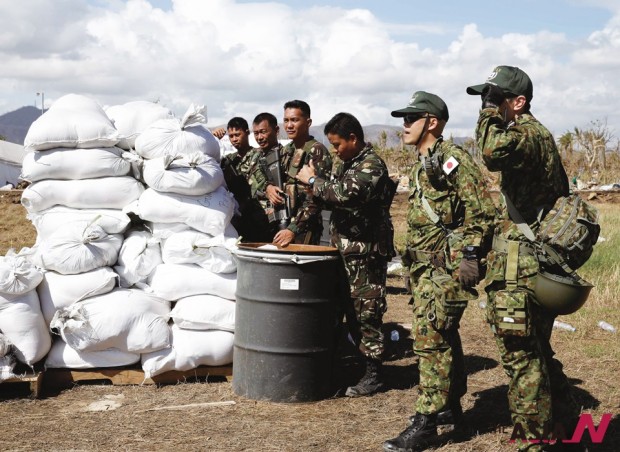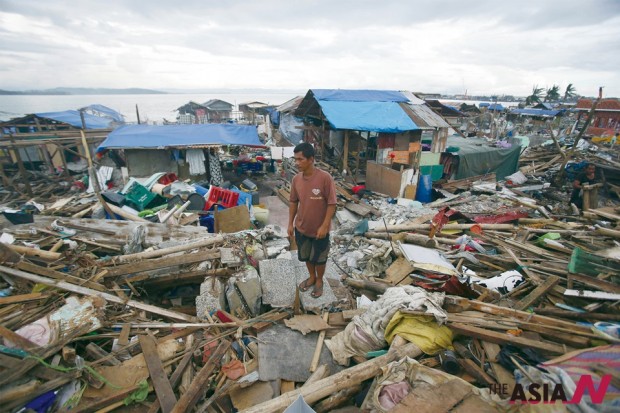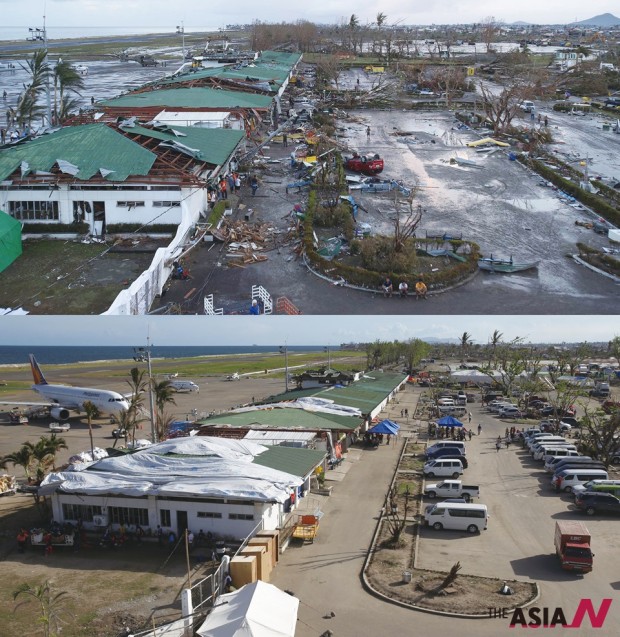Haiyan, the agony you left and heroes you brought!

I have been to Tacloban City many times before, and have also visited other places in the provinces of Leyte and Samar. These are in the Eastern Visayas region of the Philippines. These places are exceptionally beautiful, especially Tacloban City, the major trading and commercial hub in the region. This part of the Philippines is also known to be gifted with natural resources – coconuts and coastal beaches – and a lively people that take pride in their coconut wine and their singing prowess. Like the rest of the Filipinos, the Bisayans are very hospitable and cheerful.
I went back to Tacloban City last November 11, 2013, exactly three days after Typhoon Yolanda (International Name: Haiyan) left its track of devastation throughout the whole Eastern Visayas. Our team was led by Mr. Ramon Tulfo, a public service radio broadcaster and columnist. With us were the staff of our radio program and two dozen volunteer doctors from the Sagip-Bayan (Save the Community) Foundation of St. Luke’s Medical Center. Bearing medicine, water, food items, blankets and plastic sheets, we boarded a commercial flight from Manila on an early morning that was unnaturally sad for me. Before departing, we were preparing ourselves on what to expect in Tacloban. Based on what we saw on TV, heard on the radio or read in the newspapers, we tried to prepare ourselves for what we would see first hand.
That one-hour flight was the longest one I had ever had. Unlike my other trips, this one was not full of excitement.
This time, I was nervous. There was tension and uneasiness in the air. Questions were whispered around, “Are the images in the news true?”
I needed to have a window seat to have an aerial view of our landing and see the impacts of the super typhoon. As our plane made its descent, my worst fears came true. I was shaking and the shock set in.
What hit me was a surreal picture. Think of the most beautiful landscape painting you have ever seen. Then imagine a giant eraser suddenly rubbing out the whole place. That was what happened to me when I looked out the plane window. “Welcome to Tacloban City,” the flight attendant said. I had never heard that phrase sound more sad.
Upon exiting the plane, I saw the monstrous impact of the typhoon. The stench of destruction and death was overwhelming. The walls and roof of the airport terminal were gone, barely a shell of the structure was standing. And it was to become our command center. There were many military cargo planes and helicopters parked along the tarmac.
Soldiers were everywhere – running with relief goods, marshalling the huge crowds outside the airport and setting up make-shift tents.
But, what was startling was the number of survivors outside the airport gate. They were shoving towards the gate, trying desperately to get a chance to board the planes that were returning to Manila. “Were we really in Tacloban City?” My eyes could see it, but my brain was refusing to acknowledge it and my emotions were certainly rejecting it.
Our group’s mission was to extend medical help and support our fellow Filipinos who survived the typhoon. Their pleas for help were deafening. The cries and the agonies of the victims being operated on by our volunteer doctors were a painful wound in my ears and soul.
Those needing medical attention wormed towards our make-shift operating room (an office table propped up by steel drums and some plastic streamers wrapped around to give some privacy). Medicine and water were also distributed. There was no room for fatigue and tiredness, because the stories I listened to were too overwhelming – how they survived the ravaging waves, how they saw their families and properties being swept away, how everything came suddenly in an angry rush of white waves in the darkness of the early morning. The chilling stories ended up the same way – their loved ones were engulfed by an infuriated and hungry sea.

Everyone a hero!
Those who survived bear the life-long scars – physical wounds from being hit by roofs or doors or even smashing into cars while being swept by the storm surge and emotional scars on losing so many in so little time. Many children lost their parents. But, fewer things are more agonizing than a parent losing a child. Everyone was a victim here.
I will never forget the scene I witnessed of a family that was put in a dilemma. After days of waiting to catch a plane ride to Manila, due to space limitations in the C-130 cargo plan, only children, those needing medical attention and the elderly were being prioritized for boarding. And so mommy and daddy were told they had to stay, while their eldest daughter (age 12) and youngest daughter (age 7) would be allowed to go to Manila.
Tears were running down the faces of mom and dad, as they pushed their daughters into the plane. More tears were flowing from the children’s eyes, as they pleaded, “No mama, we want to stay with you! We don’t want to go!” But, mommy and daddy were strong. “You have to go! Protect and take care of each other! Don’t lose the address of your auntie in Manila. We will see each other again there. We promise you!” Mommy pleaded to a stranger inside the plane, standing beside her daughter, “When you arrive in Manila, please help my two daughters!” And daddy politely asked the soldier, choking down his tears, “Please sir, when you arrive in Manila, please make sure they can make a phone call to my sister.” And their hands parted as reluctantly as they could, the heavy feeling of being separated almost visible in the air.
I promised myself before flying in here to Tacloban City that I would be strong for all of these people. And yet at that moment, the river of tears from my heart and my eyes would not stop.
Three days, we ate irregularly and re-heated the same packed food. But, these survivors have been almost starving for more than 3 days now. Three days of no shower for us, and we were starting to stink. But, these people have been fighting for drinking water for the last three days. Three nights, we barely could sleep, as there were no beds and no electricity. But these people did not even have a tent to shelter them from the cold night. After three more days, we would have a plane ride back to Manila. These people only had uncertainty on where to go next. Haiyan, look at the agony you left!

We returned to Tacloban City last November 25, 2013, in fact just a few days after doing our first medical mission.
This time we were a bigger group, forty-nine people in all, including two groups of volunteers of doctors from the Sagip-Bayan (Save the Community) Foundation of St. Luke’s Medical Center and the Chinese General Hospital. We also had brought with us a more sizable amount of food items and medicine for our 3-day medical mission.
Barely a week after leaving Tacloban City, I could see the dramatic changes that had occured since. I was still largely disoriented with all the flattened houses and structures, but there was a semblance of order, if not a calm acceptance of relief efforts. The biggest surprise however, was the unbelievable number of foreign soldiers in the airport and within the city limits. I have been to some military operations in the past, including similar relief efforts, but the number of foreigners here helping out was both staggering and heart-warming.
Everyone and everything was busy, moving quickly, as if the desperation of the survivors was pushing them to be more energetic, more prompt, more responsive – the urgency of the situation always a shadow at one’s back.
I am briefly consoled by the fact that the lines of people waiting to get out of Tacloban City have become short and orderly. The garbage and debris from the storm surge had been cleaned out, and the major streets were passable now. Giant tents have sprung out like mushrooms surrounding the airport area, and the city hall as well. These are the command centers and hubs of the relief operations of the various humanitarian agencies.
Everyone is pitching in and giving their small contribution whether it is their knowledge, expertise, time, or their resources. There is a potable water supply now. The major roads within the city and those going out to other towns are now passable, making the delivery of relief goods much easier. Some hospitals are now running again with generators.
Several commercial establishments such as banks and restaurants have also opened. Without a doubt, the recovery of Tacloban City and Leyte Province is now starting.
I am witnessing right now the height of international solidarity, of the global village working together to help those in need – this time it is us. Everyone cares, and wants to do their share. It is very heart-warming, and I am comforted that the invisible hand of a greater being is at work here. Race, color, creed, and economic standing are all set aside. Differences are irrelevant.
The monumental job of recovery and restruction is daunting indeed. But with all these heroes giving their share – both small and big – everything counts. Everyone is a hero. And I am thankful for that.




